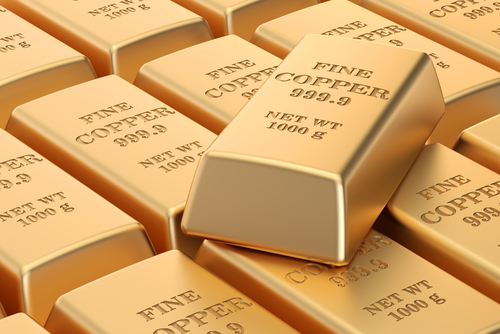So, you want to learn about investing in copper, huh? Well, my friend, you’ve come to the right place. In this beginner’s guide, I’ll walk you through the ins and outs of investing in this versatile metal.
Now, investing in copper might seem like a daunting task at first, but fear not! I’ll break it down for you in simple terms. First and foremost, you need to understand the various ways you can invest in copper. You could consider buying physical copper, like coins or bars, or you could opt for investing in copper through exchange-traded funds (ETFs) or stocks of companies involved in copper mining or production. It’s all about finding the approach that suits your investment goals and risk tolerance. Additionally, it’s important to keep an eye on the factors that impact copper prices, such as supply and demand dynamics, global economic trends, and geopolitical factors. Staying informed and conducting thorough research will be key to making sound investment decisions. So, let’s dive into the world of investing in copper and explore the exciting opportunities it holds. Are you ready to embark on this investment journey? Let’s get started!
A Beginner’s Guide to Investing in Copper

This image is property of smartasset.com.
Understanding the Basics of Copper
Copper, a versatile and valuable metal, has been an essential part of human civilization for thousands of years. From ancient civilizations to modern industries, copper is widely used due to its excellent conductivity, resistance to corrosion, and malleability. In this section, we will delve into the historical background, properties, uses, and global production of copper, providing you with a comprehensive understanding of this valuable commodity.
History of Copper as a Commodity
Copper has a rich history as a highly sought-after commodity. It was one of the first metals discovered by humans, and its use dates back to ancient times. In fact, copper artifacts have been found dating as far back as 9000 BC. Over the centuries, copper has played a significant role in various civilizations, from the Bronze Age to the Industrial Revolution, and continues to be a crucial component of modern society.
Properties and Uses of Copper
Copper possesses unique properties that make it indispensable in various industries. Its exceptional thermal and electrical conductivity make it a preferred material for electrical wiring, plumbing, and electronics. Additionally, its corrosion resistance and antimicrobial properties have led to its extensive utilization in infrastructure, such as roofing, piping, and construction materials.
Global Copper Production
Copper is sourced from mines around the world, with global copper production reaching millions of metric tons annually. The largest copper-producing countries include Chile, China, Peru, the United States, and Australia. Understanding the dynamics of copper production and distribution is crucial in assessing supply and demand fundamentals that influence copper prices.
Major Copper-Producing Countries
Chile is the leading global producer of copper, accounting for a substantial portion of the world’s supply. Other major copper-producing countries include China, Peru, the United States, and Australia. Variations in copper production across these nations can impact market dynamics and price fluctuations.
Copper Supply and Demand Dynamics
The balance between copper supply and demand significantly affects market conditions and prices. The increasing demand for copper in emerging economies, particularly in sectors such as construction, infrastructure, and electric vehicles, has put pressure on supply chains. Understanding the complex interplay between global supply and demand dynamics is essential for investors interested in copper.
Understanding Copper Grades and Purity
Copper grades and purity levels vary depending on the source and extraction method. High-quality copper, with greater purity, generally commands higher prices due to its superior conductivity and desirability in critical industries like electronics. Investors should familiarize themselves with the different copper grades and purity standards to make informed investment decisions.
Benefits of Investing in Copper
Investing in copper as a part of a diversified portfolio can offer numerous advantages. In this section, we will explore the key benefits of including copper investments in your financial strategy.
Copper as a Hedge Against Inflation
Copper has historically served as a hedge against inflation. During periods of inflation, the value of many currencies declines, while tangible assets like copper tend to maintain their worth. As inflation erodes purchasing power, the demand for copper, driven by its significant industrial usage, often remains stable or increases, making it an attractive option for investors seeking to protect their wealth.
Diversification Benefits of Copper
Diversification is a fundamental principle of successful investing, and copper can play a valuable role in achieving a well-balanced portfolio. The performance of copper is often uncorrelated with other assets like stocks or bonds, reducing the overall risk exposure of an investment portfolio. By diversifying with copper, investors increase their chances of stability and potential higher returns, even during market downturns.
Copper’s Role in Industrial Growth
As a key raw material for various industries, copper demand is intrinsically linked to industrial growth. As economies develop and infrastructure projects expand, the need for copper intensifies. Investing in copper provides the opportunity to ride the wave of industrial growth and capitalize on rising demand from sectors such as construction, automotive manufacturing, and renewable energy.
Projected Increase in Copper Demand
Forecasts predict a significant increase in copper demand in the coming years. The ongoing global shift towards renewable energy technologies, electric vehicles, and a rapidly expanding digital infrastructure are expected to drive unprecedented demand for this versatile metal. Investing in copper positions investors to potentially benefit from this growing demand, which could result in favorable price appreciation.
Potential for Long-Term Price Appreciation
While short-term fluctuations are common in commodity markets, copper has demonstrated a long-term trend of price appreciation. Its strong fundamentals, including limited and costly extraction methods and increasing demand from emerging economies, suggest that copper has the potential for sustained price growth over the long term. For investors with a long investment horizon, copper offers an opportunity for capital appreciation and wealth accumulation.

This image is property of blog.providentmetals.com.
Factors Affecting Copper Prices
Copper prices are influenced by a multitude of factors, ranging from economic indicators to geopolitical developments. Understanding these factors is crucial for investors to make informed decisions. In this section, we will explore the key factors that affect copper prices.
Economic Factors
Economic indicators, such as GDP growth, manufacturing activity, and consumer spending, strongly impact copper prices. A flourishing economy typically signals increased demand for copper, as it is a fundamental component in many industries. Conversely, economic downturns can lead to lower copper prices due to reduced industrial activity and weakened demand.
Geopolitical Factors
Geopolitical events and policies can have a significant impact on copper prices. For example, trade tensions between major economies can disrupt global supply chains and create market uncertainty, leading to price volatility. Additionally, political instability in copper-producing countries may disrupt production and affect global supply levels, influencing price movements.
Copper Market Speculation
Speculation plays a role in the fluctuation of copper prices. Traders and investors, driven by their expectations of future price movements, can engage in speculative buying or selling of copper futures contracts, leading to short-term price volatility. Monitoring market sentiment and trader behavior is essential for investors seeking to understand short-term price movements.
Technological Advances Impacting Copper Demand
Technological advancements can greatly influence copper demand. The development of new technologies, such as electric vehicles, renewable energy systems, and 5G infrastructure, increases the need for copper and can lead to long-term price appreciation. Staying informed about emerging technologies and their potential impact on copper demand is crucial for investors aiming to identify future investment opportunities.
Environmental Regulations and Sustainability
Environmental regulations and sustainability initiatives are increasingly affecting the copper market. Stricter environmental standards can affect production costs and limit supply. Additionally, the increasing focus on sustainable practices and responsible mining can impact consumer demand for copper. Investors should be aware of evolving environmental regulations and sustainable practices in the copper industry to make socially responsible investment decisions.
Different Ways to Invest in Copper
Investors have several avenues to gain exposure to the copper market. Whether through physical ownership, exchange-traded funds (ETFs), futures trading, or investing in copper stocks, each approach has its unique characteristics and potential benefits. In this section, we will explore the different ways investors can invest in copper.
Physical Copper Ownership
One option for investing in copper is to purchase physical copper, such as bars or coins. Physical ownership allows investors to directly possess and store copper, providing a tangible asset that can potentially appreciate in value. However, acquiring and storing physical copper may involve additional costs and logistics considerations.
Copper ETFs and Exchange-Traded Products
Copper ETFs, also known as exchange-traded products (ETPs), provide investors with a convenient and cost-effective way to gain exposure to copper prices without owning the physical metal. These investment vehicles track the price of copper and offer liquidity, allowing investors to easily buy or sell shares. Copper ETFs can be an attractive option for those seeking flexibility and diversification within their investment portfolio.
Investing in Copper Futures and Options
Trading copper futures and options on commodity exchanges provides investors with a speculative approach to investing in copper. Futures contracts enable investors to speculate on the future price movements of copper without owning the physical metal. However, futures trading requires a higher level of expertise and carries additional risks, such as leverage and margin requirements.
Direct Investment in Mining Companies
Investing directly in copper mining companies allows investors to participate in the profits and growth of the industry. By analyzing the financial performance, management, and growth prospects of mining companies, investors can identify opportunities for capital appreciation. However, investing in individual stocks entails specific risks associated with the performance of the company and the mining sector as a whole.
Copper Stock Mutual Funds and Exchange-Traded Funds (ETFs)
Mutual funds and ETFs that focus on copper stocks provide investors with a diversified approach to copper investment. These funds pool investors’ capital to invest in a range of copper mining companies, spreading the risk across multiple holdings. Copper stock mutual funds and ETFs offer convenience and professional management for those seeking exposure to the copper sector without the need for individual stock selection.

This image is property of smartasset.com.
Physical Copper Investments
Investors interested in the tangible appeal of copper can consider physical ownership as an investment option. In this section, we will explore the various aspects of physical copper investments and the considerations involved.
Purchasing Copper Bars
One way to invest in physical copper is by purchasing copper bars. Copper bars are available in different sizes and purities, ranging from small investment-grade bars to larger industrial-grade bars. When purchasing copper bars, investors should ensure they are buying from reputable sources and consider factors such as the purity, weight, and authenticity of the bars.
Investing in Copper Coins
Another option for physical copper ownership is investing in copper coins. Copper coins offer the advantage of being smaller and more manageable compared to bars. They are often produced by government mints and may feature numismatic or commemorative designs. As with copper bars, investors should verify the authenticity and purity of copper coins before making a purchase.
Storing and Safekeeping Physical Copper
Proper storage and safekeeping of physical copper are essential to preserve its value and prevent damage. Investors should consider secure storage options that protect copper from environmental factors, theft, and fluctuations in temperature and humidity. Options for storage include personal safes, safety deposit boxes, or specialized storage services provided by reputable institutions. Evaluating the cost and logistics of storing physical copper is crucial before making an investment.
Investing in Copper ETFs
Exchange-traded funds (ETFs) offer investors a convenient and accessible way to gain exposure to the performance of copper without owning the physical metal. In this section, we will delve into the world of copper ETFs, exploring their types, benefits, risks, and considerations when selecting the right ETF.
Understanding Copper ETFs
Copper ETFs are investment funds traded on stock exchanges that aim to track the performance of the copper market. These funds typically hold copper futures contracts or physical copper to replicate the price movements of the metal. Copper ETFs provide investors with a diversified exposure to copper prices, offering flexibility, liquidity, and transparency compared to other investment options.
Types of Copper ETFs Available
There are various types of copper ETFs available, each with its own investment strategy and structure. Some ETFs hold physical copper, while others utilize futures contracts or a combination of investment instruments. Understanding the differences between ETFs, such as their tracking methodologies and underlying assets, will help investors select the most suitable option for their investment goals and risk tolerance.
Benefits and Risks of Copper ETFs
Investing in copper ETFs offers several benefits for investors. These funds provide easy access to the copper market without the need for physical ownership or futures trading expertise. Copper ETFs also offer liquidity, as they can be bought or sold throughout the trading day. However, investors should be aware of the risks associated with ETFs, such as tracking error, market volatility, and fees, and carefully consider their investment objectives before committing capital.
Choosing the Right Copper ETF
Selecting the right copper ETF requires careful consideration of various factors, such as investment objectives, fund expenses, liquidity, and tracking error. Investors should assess the performance history, assets under management, and the fund manager’s expertise. Additionally, comparing fees and expenses can help investors minimize costs and maximize returns. Conducting thorough research and seeking professional advice can assist investors in making informed decisions.

This image is property of blog.providentmetals.com.
Trading Copper Futures
Trading copper futures provides an opportunity for investors to profit from anticipated price movements without owning the physical metal. In this section, we will explore the basics of copper futures trading, including how futures contracts work and the factors traders should consider.
Introduction to Copper Futures
Copper futures contracts are standardized agreements to buy or sell a specific amount of copper at a predetermined price and future date. These contracts trade on commodity exchanges and allow market participants to speculate on copper price movements or hedge against potential price fluctuations. Copper futures provide an avenue for short-term trading opportunities and the potential for higher leverage.
Understanding How Copper Futures Work
Copper futures contracts are traded on commodity exchanges, with each contract representing a specific quantity of copper. Traders can go long (buy) if they believe copper prices will rise or go short (sell) if they anticipate a price decline. The profit or loss is realized upon closing the position or upon expiration of the contract. Trading copper futures requires familiarity with market dynamics, technical analysis, and risk management strategies.
Factors to Consider in Copper Futures Trading
Successful copper futures trading involves considering various factors that can influence copper prices. Traders should closely monitor macroeconomic indicators, geopolitical events, and supply and demand fundamentals related to the copper market. Utilizing technical analysis tools, such as chart patterns and indicators, can assist traders in identifying potential entry and exit points. Risk management, including setting stop-loss orders and managing leverage, is critical to minimizing losses and protecting capital.
Managing Risks in Copper Futures Trading
Copper futures trading carries inherent risks, and prudent risk management is vital for traders. Volatility in the copper market can lead to rapid price movements, amplifying potential gains but also increasing the risk of significant losses. Employing risk mitigation strategies, such as setting predetermined exit points and diversifying trades, can help traders navigate the inherent uncertainties of futures trading. Continuous monitoring of market conditions and staying informed about copper-related news is essential for effective risk management.
Investing in Copper Stocks
Investing in copper stocks provides investors with an opportunity to participate in the profitability and growth potential of copper mining companies. In this section, we will explore the advantages and considerations of investing in copper stocks, along with strategies for selecting the right companies.
Analyzing Copper Mining Stocks
Analyzing copper mining stocks involves thorough research and evaluation of various factors. Fundamental analysis techniques, such as examining financial statements, assessing management competence, and analyzing growth prospects, help investors gauge the health and potential profitability of mining companies. Understanding the operational efficiency, reserves, and production growth of copper mining firms is crucial in identifying suitable investment opportunities.
Choosing the Right Copper Stocks
Choosing the right copper stocks entails considering several factors, including the company’s financial health, growth opportunities, and risk tolerance. Investors should evaluate the financial ratios, earnings reports, and long-term growth strategies of potential copper mining investments. Additionally, diversifying investments across multiple mining companies can help spread risk and capture potential returns from various market conditions.
Diversifying Copper Stock Investments
Diversification is essential when investing in copper stocks to mitigate risk and optimize returns. By spreading investments across multiple copper mining companies, investors reduce their exposure to the performance of a single stock or mining operation. A diversified portfolio of copper stocks can help offset the impact of poor performance from individual companies and capture the potential upside from sector-wide growth trends.
Monitoring Copper Price Trends for Stock Investing
Monitoring copper price trends is crucial for investors in copper mining stocks. Copper prices significantly influence the profitability of mining companies, as higher prices can boost revenue and vice versa. Investors should stay informed about market fundamentals, global demand trends, and supply dynamics, as well as monitor macroeconomic indicators that may impact copper prices. Regularly assessing and adjusting investments based on copper price trends is vital for successful stock investing.

This image is property of i.ytimg.com.
Analyzing Copper Mining Companies
Analyzing copper mining companies requires a comprehensive assessment of financial performance, operational efficiency, management competence, and environmental and social factors. In this section, we will explore the key areas to consider when analyzing copper mining companies for investment purposes.
Financial Analysis of Copper Mining Companies
Financial analysis provides insights into the health and profitability of copper mining companies. Investors should evaluate financial statements, including balance sheets, income statements, and cash flow statements, to assess liquidity, profitability, and solvency. Analyzing financial ratios and past performance helps identify mining companies with solid financial foundations and the potential for future growth.
Assessing Mining Operations and Reserves
Mining operations and reserves play a significant role in the success of copper mining companies. Assessing the efficiency, productivity, and cost-effectiveness of mining operations helps investors understand the company’s ability to generate profits. Evaluating the reserve base, including proven and probable copper reserves, provides insight into the long-term sustainability and growth prospects of mining companies.
Understanding Management and Corporate Strategy
Management competence and corporate strategy are crucial considerations when investing in copper mining companies. Evaluating the experience and track record of the management team helps assess their ability to navigate challenges and capitalize on opportunities. Understanding the company’s growth strategies, expansion plans, and commitment to sustainability provides valuable insights into the long-term viability and potential success of the mining operation.
Evaluating Environmental, Social, and Governance Factors
Environmental, social, and governance (ESG) factors are increasingly important considerations for investors. Assessing a mining company’s ESG practices involves evaluating its environmental impact, social responsibilities, and governance structure. Investors should consider factors such as compliance with environmental regulations, community engagement, labor practices, and transparent reporting. Investing in companies that prioritize sustainability and responsible mining practices aligns with socially responsible investing principles.
Evaluating Copper Market Trends
Evaluating copper market trends involves an in-depth analysis of price volatility, supply and demand dynamics, technological advancements, and global economic outlook. In this section, we will explore the key aspects to consider when assessing copper market trends.
Copper Price Volatility and Trends
Copper prices exhibit volatility due to factors such as economic indicators, market speculation, and supply and demand dynamics. Analyzing historical price trends and monitoring short-term and long-term price movements helps investors identify patterns and potential opportunities. Understanding the causes of price volatility and factors that influence trends is essential for making informed investment decisions.
Supply and Demand Analysis
Supply and demand dynamics play a vital role in determining copper prices. Monitoring global supply levels, including mine production, refined copper output, and inventory levels, helps assess the potential impact on prices. Analyzing trends in copper consumption, driven by sectors like construction, electric vehicles, and electronics, provides insights into future demand. Evaluating the balance between supply and demand helps identify potential price drivers.
Technological Innovations Impacting Copper Market
Technological innovations and advancements influence the copper market significantly. Emerging technologies such as electric vehicles, renewable energy infrastructure, and 5G networks drive copper demand. Monitoring technological developments and industry trends helps investors understand the potential impact on copper consumption and anticipate growth opportunities. Staying informed about advancements in copper usage enables investors to align their portfolios with the evolving needs of modern industries.
Global Economic Outlook and Copper
The global economic outlook is closely linked to copper demand and pricing. Economic indicators, such as GDP growth rates, construction activity, and infrastructure spending, provide insights into the health of major copper-consuming economies. Monitoring macroeconomic trends and forecasts helps investors anticipate shifts in copper demand and establish investment strategies that align with broader economic conditions.
Industry and Infrastructure Developments
Industry developments, such as new infrastructure projects and industrial expansions, have a significant impact on copper demand. Monitoring announcements and progress regarding government infrastructure initiatives, urbanization projects, and technological advancements provides insights into upcoming demand trends. Investing in copper should consider both short-term projects and long-term industry developments to capitalize on potential growth opportunities.
Assessing the Risks of Investing in Copper
Investing in copper, like any other asset class, entails risks that investors should carefully evaluate. In this section, we will explore the key risks associated with copper investments to assist investors in making informed decisions.
Commodity Price Risk
Copper, like all commodities, is subject to price volatility, which can result in significant profit or loss for investors. Fluctuations in global supply and demand levels, macroeconomic trends, and market speculation contribute to price volatility. Investors should be prepared for short-term price fluctuations and employ risk management strategies to mitigate potential losses.
Geopolitical and Country-Specific Risks
Geopolitical factors and country-specific risks can impact copper prices and investments. Political instability, changes in government regulations, trade disputes, and social unrest in major copper-producing countries can disrupt supply chains and cause price volatility. Investors should stay informed about geopolitical developments that may impact copper markets and adjust their investment strategy accordingly.
Financial Risks
Investing in copper carries financial risks associated with the performance of copper mining companies or investment vehicles. Poor financial performance, high debt levels, declining copper prices, and mismanagement can result in decreased shareholder value. Investors should perform thorough financial analysis and due diligence when selecting copper-related investments to minimize financial risks.
Operational and Market Risks
Investments in copper mining companies can be exposed to operational and market risks. Mining operations face challenges such as accidents, labor strikes, natural disasters, and production disruptions. Market risks include fluctuations in copper prices, changes in demand patterns, and intense competition. Evaluating the operational efficiency, risk management practices, and market positioning of mining companies is crucial in managing operational and market risks.
Regulatory and Environmental Risks
Regulatory and environmental risks are important considerations in copper investments. Changes in government policies, regulations, or environmental standards can impact mining operations, leading to increased costs or production constraints. Companies with inadequate environmental practices may face legal consequences and reputational damage. Assessing a company’s compliance with regulations and its commitment to sustainable practices enables investors to make informed decisions and align with responsible investment principles.
In conclusion, understanding the basics of copper, benefits of investing in copper, factors affecting copper prices, different investment options, and associated risks allows investors to make informed decisions when entering the world of copper investing. By considering both the potential rewards and risks, investors can develop a well-rounded strategy to explore the opportunities presented by this versatile and valuable metal. Remember, as with any investment, conducting thorough research and seeking professional guidance is crucial for maximizing returns and managing risk. Happy investing!










